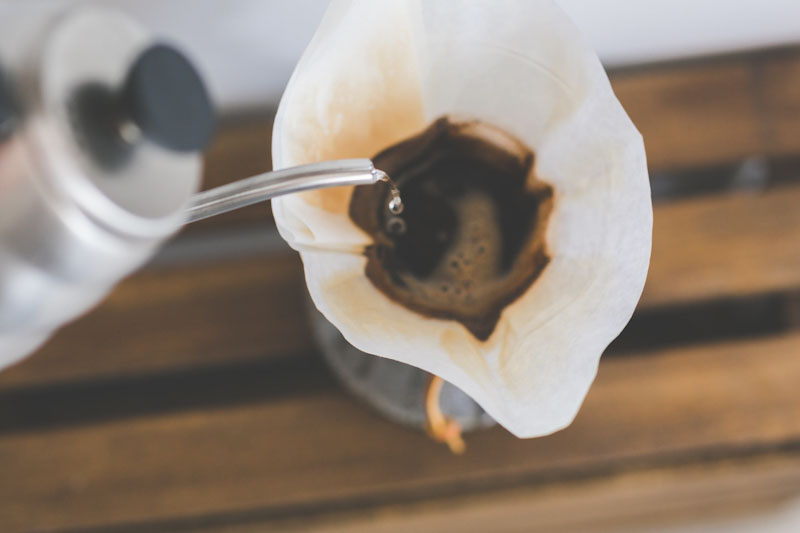What Is Pour Over Coffee?
For those who have heard about pour-over coffee, but are not quite sure what it is, this is then the article for you.
Pour-over coffee is exactly what it sounds like…you pour hot water over freshly ground coffee beans. You basically create a very clean tasting brew by pouring water slowly over a coffee bed, extracting the coffee from the beans, collected at the bottom by your cup or collecting jug.
I personally love any pour-over brewing method, not only because it creates an exceptional cup of coffee, but because you can control the outcome of your result, such as the taste and strength, better than with other brewing methods.
Pour over coffees are best described as a clean tasting coffee. If you have never been able to drink a cup of coffee without milk, try it with any pour-over method…you will be surprised!
My first black cup of coffee was from a Chemex, and it was so smooth and easy drinking that I could not help but to start experiment more with different pour-over methods.
What you will need for a Pour Over Filter Coffee:
- Freshly ground coffee
- A coffee filter (like filter paper)
- A pour-over brewer
Keep in mind that even though manual brewing sounds quite easy, each brewing method has its rules/guidelines in order to create a good cup of coffee. It also requires patience, practice and persistence.
It is important to follow all the steps and to not cut corners if you want to make amazing coffee. Apart from the obvious – a pour-over/drip coffee maker, here are the tools you’ll need:
- Coffee filter (each brewer has its own filters)
- Good quality burr grinder (if you don’t have pre-ground coffee)
- Gooseneck kettle (for the optimal flow rate of hot water).
- Coffee scale (measures in grams)
- A thermometer of some way of controlling the water temperature (optional)
If you don’t have a thermometer, wait for the water to boil, then remove from heat and wait 30 seconds before brewing.
- A serving vessel (optional)
- Good quality water.
How to make Pour Over Coffee
To make a pour-over coffee definitely sounds easier than it is. The truth is, this brew style requires practice and patience.
Depending on what brewing method you choose, follow the links below that will explain each method step-by-step;
Pour Over Coffee to water ratio
The coffee to water ratio is where you have the most control over your coffee’s flavour. This is where you can control if your coffee will be strong or weak, rich or mild etc.
You will find that the most recommended ratio is 60 grams of coffee per 1000 ml of water. However, if you ask some baristas, they might use different rations, not to worry, everyone likes the way their coffee tastes. Some likes it stronger and others prefer a weaker taste.
Experiment. Try different scenarios and make note of all the ratios you have tried in order to know which you prefer the most.
As a VERY general rule, more coffee will give you more flavour.
- If you want a richer flavour, use more coffee.
- If you want a sweeter flavour, use less coffee.
Some tips for a perfect brew:
Although these tips may seem simple, it all works together which really makes the difference with this style of brewing:
- Have a good quality grinder
Take time to choose the right coffee grinder as your grind is such an important part of brewing coffee.
Grinding exposes all volatile flavours and aromatics locked in the coffee bean. Grind size will greatly affect the coffee you brew. – Kicking Horse Coffee.
The grind size is a crucial factor in manually brewing filter coffee. If the grind size is too small, your coffee can have a burnt and bitter taste and if the grind size is too big, your coffee will have a high acidic taste.
This is all due to over and under extraction.
Again…it is so important to have the right grind size!
Have a look at the link from Homegrounds on grind size as well as under- and over-extraction; coffee grind size chart here.
- Let your coffee bloom
Blooming is a term used to describe the releasing of carbon dioxide in the coffee.
Carbon dioxide builds up in the grounded coffee, and this will not allow good penetration of water if not released.
You release the carbon dioxide by blooming or wetting the coffee.
Pour enough water into your grounds to wet them, give it about 30 seconds. You will see that the coffee grounds will start to swell/expand (blooming). Then continue to pour over the remaining of the water.
- Be consistent
Consistency is key in creating that perfect cup of coffee. Of course, you might make some ‘not so great’ brews at first, but that is why practicing is important!
Also make note of all the ratios you have tried, to know what you did not like, or which ratio gave you an amazing cup of coffee.
- Clean your equipment
Give your brewing equipment the clean it deserves once you’re finished with it to ensure its devoid of coffee oils before you begin next time. Your taste buds will thank you.
Also, for more information, check out the entre on Caffeine Talk on How to Make the Perfect Pour-over
ON ANOTHER NOTE:
We all have probably heard that instead of tossing the used coffee grounds to the bin, we should use it in the garden…and yes we can, however I suggest reading this article first;
Coffee Grounds in the Garden – Uses, & When NOT to Use Them
References
- Home Grounds – Grinding Chart
- Home Grounds – How to make Pour Over Coffee


This was so helpful!